User Identification based on Leakage Current
Abstract
The convenience of laptops brings with it the risk of information leakage, and conventional security systems based on the password or the explicit biometric do little to alleviate this problem. Biometric identification based on anatomical features provides far stronger security; however, a lack of suitable sensors on laptops limits the applicability of this technology. In this paper, we developed a behavior-irrelevant user identification system applicable to laptops with a metal casing. The proposed scheme, referred to as LeakPrint, is based on leakage current, wherein the system uses an earphone to capture current leaking through the body and then transmits the corresponding signal to a server for identification. The user identification is achieved via denoising, dimension reduction, and feature extraction. Compared to other biometric identification methods, the proposed system is less dependent on external hardware and more robust to environmental noise. The experiments in real-world environments demonstrated that LeakPrint can verify user identity with high accuracy (93.6%), while providing effective defense against replay attacks (96.5%) and mimicry attacks (90.9%).
Background
Leakage Current
As a laptop with a metal casing (such as a MacBook) is connected to a power source, the metal casing of the laptop will carry the leakage current from the adapter [1]. This leakage current comes from the Y-capacitor of the adapter’s safety capacitor, which is part of the EMI (Electromagnetic interference) filtering circuit of the switching power supply to eliminate common mode interference and improve electro- magnetic compatibility, and is usually configured on both the high and low voltage sides of the SMPS (switch mode power supply). As a common mode capacitor, grounding of the Y capacitor generates leakage current [26]. The leakage current in the metal casing can be written as:
\[I = 2 \pi f C_h U_h + k C_l U_l\]where the leakage current in the high voltage side is \(2 \pi f C_h U_h\). \(f\) refers to the mains frequency, \(C_h\) indicates the size of the capacitor, and \(U_h\) indicates the voltage. In the low-voltage side, \(k\) is the leakage current constant (about 0.01 to 0.03 depending on the manufacturer), \(C_l\) and \(U_l\) denote the corresponding \(Y\) capacitor and voltage. The \(Y\) capacitors used in laptop adapters are typically around 5nF. Therefore, a laptop powered by the 220V /50H z mains generates roughly 0.3mA of leakage current at the casing (\(U_l = 12V\)).
Researchers [2] have used wristbands equipped with electrodes to collect electrical signals from the human body; however, those methods depend entirely on external hardware. We sought to build a more generalizable signal transmission channel between the laptop and user. As shown in Fig. 1(a), with the user’s hands placed on the laptop and the feet on the ground, leakage current flows from the laptop through the human body and eventually into the ground.
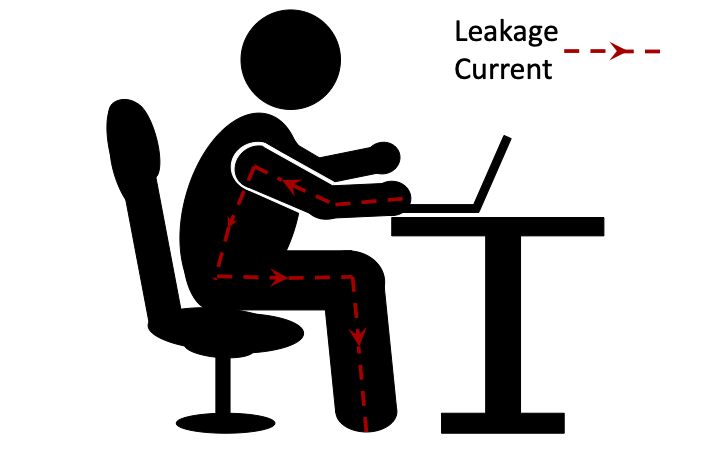
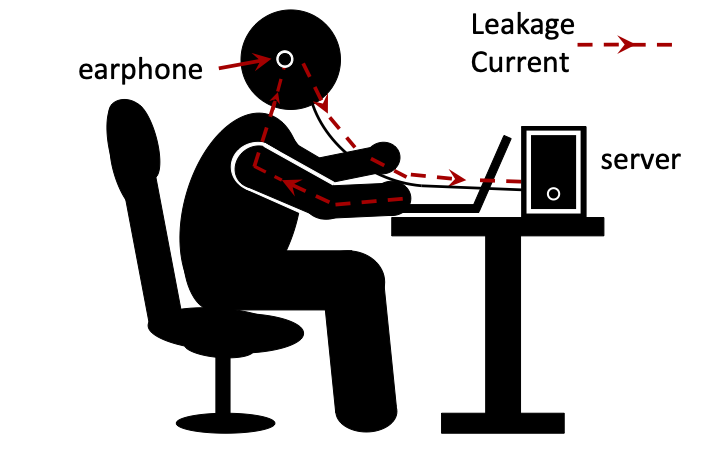
User Identification
Leakage current flowing through the body can be affected by the anatomical traits of the individual (e.g., blood vessels, muscle, fat, bone), leading to subtle differences in impedance [3] with corresponding variations in signal attenuation at different frequencies. Preliminary experiments were conducted to verify the feasibility of the system. A MacBook Pro was used to collect data from two volunteers, both of whom were asked to place a hand in the same fixed position on the right side of the touchpad, while data was collected from a single channel of the earphone.
Most of the biometric characteristics were distributed in the high frequency band (stable in 55KHz and 70KHz), as shown in Fig. 2. Samples (duration = 1s) were analyzed in terms of frequency distribution after FFT (Fast Fourier Transform). As shown in Fig. 3(a), different users presented obvious differences in distribution and amplitude at some frequencies. As shown in Fig. 3(b), the two samples obtained from the same volunteer were extremely similar in terms of frequency distribution, with only slight differences in magnitude.
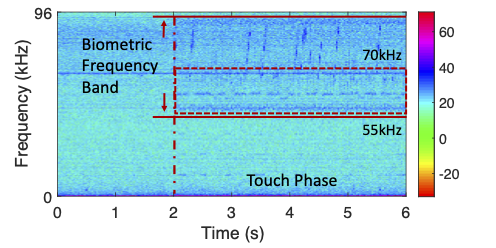
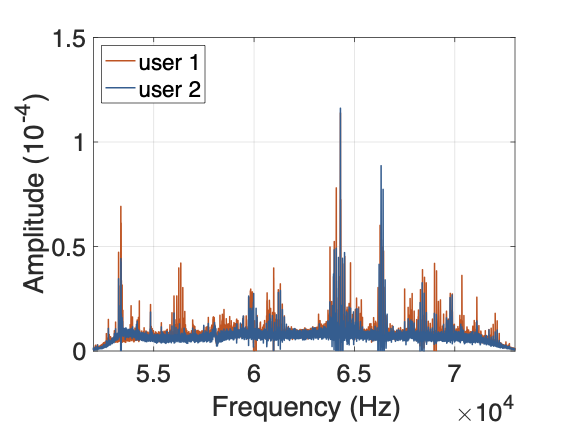
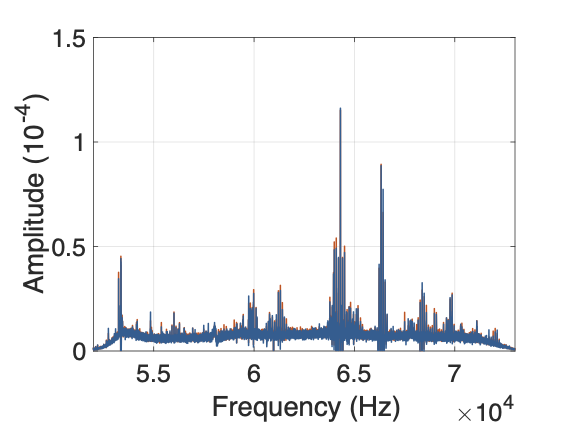
System
As shown in Fig. 4, after the leakage current detection and frequency domain transformation (FFT), the proposed system is implemented in two phases: registration phase and login phase. In the registration phase, the system is responsible for collecting samples of legitimate users and training the identification system. After the server receives the leakage current, it preprocesses the current signal. First, we use the signal of idle time as a noise sample and denoise the signal using multi-band spectral subtraction. Second, more than 90% of the user features cannot be used for identification; therefore, LeakPrint uses DC-SIS to filter out the irrelevant features to reduce the computational burden. Finally, the system uses TCN and Triplet Loss to extract behavior-irrelevant features and produce these features as a dataset for each legitimate user.
In the login phase, the system identifies the user by leakage current. First, LeakPrint detects the touch behavior by signal amplitude and preprocesses the signal, including denoising and dimensionality reduction. Then the behavior-irrelevant features are extracted by TCN. Finally, the system compares the user features with those of legitimate users in the dataset to determine the identity of the current user.
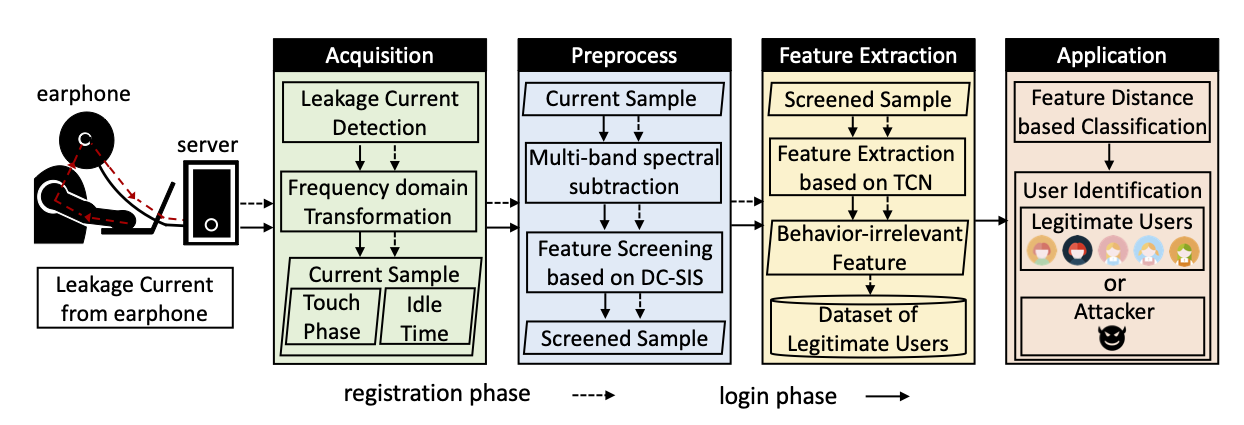
Evaluation
LeakPrint was implemented on a MacBook Pro, and a desktop computer was used as the server, as shown in Fig. 5. We chose the earphone with metal dust mesh (Meizu) to collect the leakage current. The MacBook was always on charge and placed on the desk. The user wore the earphone normally and touched the MacBook, and the earphone was connected to the server.
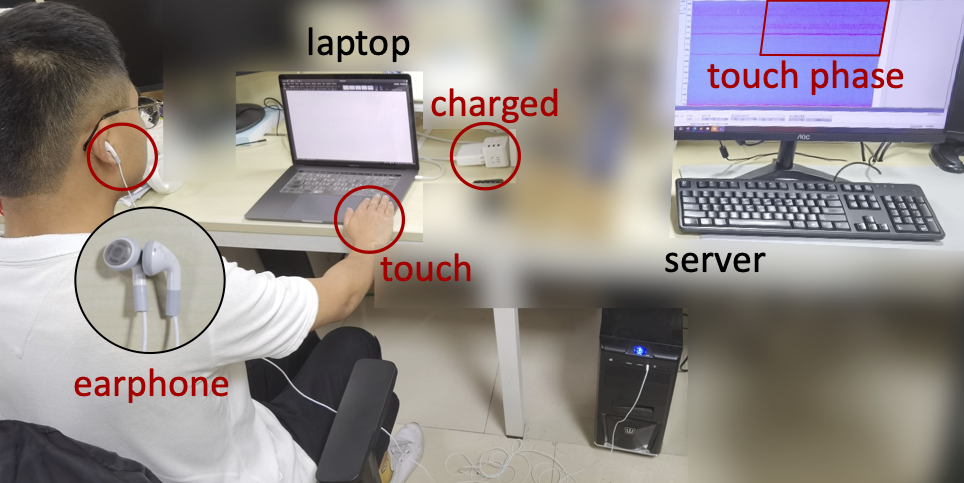
The 15 legitimate users were denoted as (U1,U2,…,U15), and the attackers were denoted as A. The average accuracy of LeakPrint in identifying legitimate users was 92.8% and 93.6% respectively in the two environments. The FAR of attacks was 9.1% and 8.7%, the FRR was 7.2% and 6.4%, and the EER was around 8.6% and 7.1% in the two environments. As shown in Fig. 6(c), we plotted the ROC (Receiver Operator Characteristic) curves consisting of FAR and FRR for the two environments. These results demonstrate that LeakPrint can accurately identify the identity of legitimate users and detect attackers, even under the effects of other influence of other electrical appliances.


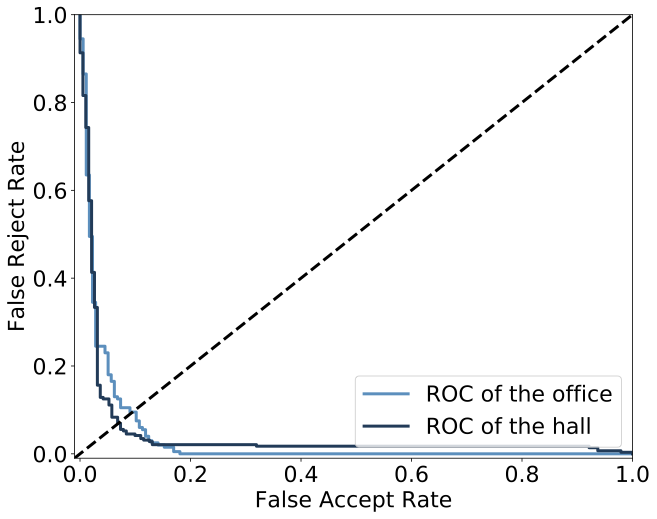
Reference
[1] M. M. Jha, K. B. Naik, and S. P. Das, “Estimation of optimum value of y-capacitor for reducing emi in switch mode power supplies,” Electrical Power Quality and Utilisation. Journal, 2009.
[2] Christian Holz and Marius Knaust. 2015. Biometric Touch Sensing: Seamlessly Augmenting Each Touch with Continuous Authentication. In Proceedings of the 28th Annual ACM Symposium on User Interface Software amp; Technology (Charlotte, NC, USA) (UIST ’15). Association for Computing Machinery, New York, NY, USA, 303–312.
[3] Ivan Martinovic, Kasper B. Rasmussen, Marc Roeschlin, and Gene Tsudik. 2017. Pulse-Response: Exploring Human Body Impedance for Biometric Recognition. Acm Transaction on Information System Security 20, 2 (2017), 6.1–6.31.